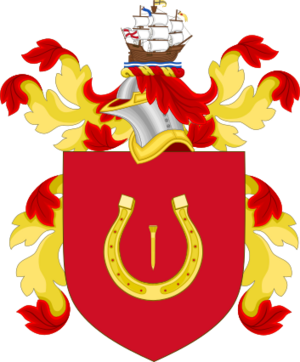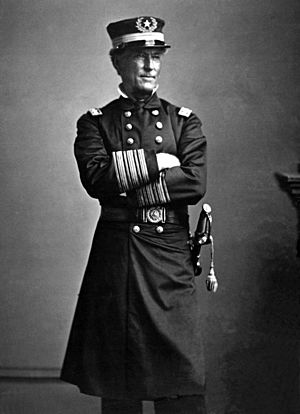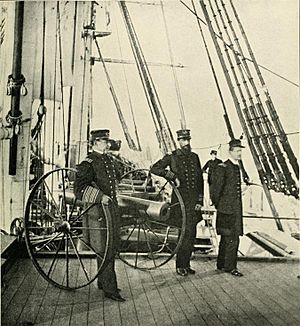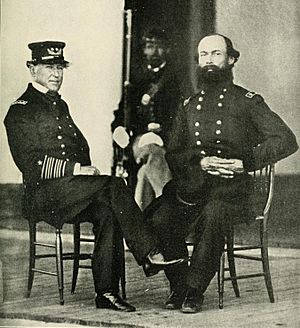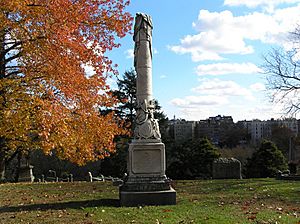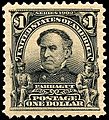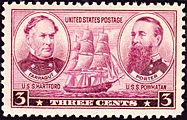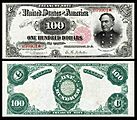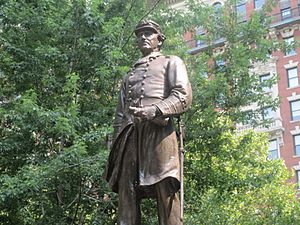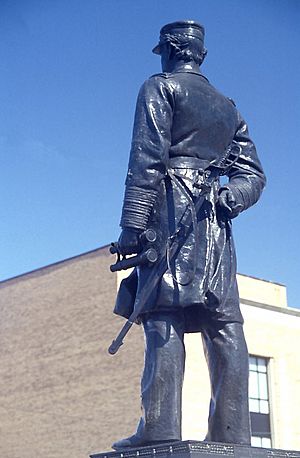David Farragut facts for kids
Quick facts for kids
David Farragut
|
|
|---|---|
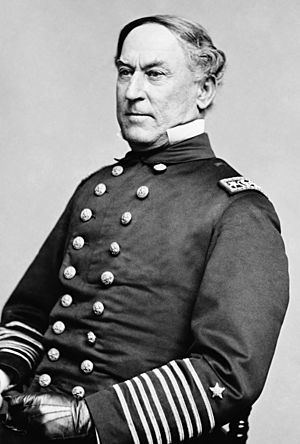
Farragut as a rear admiral, c. 1862–1864
|
|
| Birth name | James Glasgow Farragut |
| Born | July 5, 1801 Campbell's Station, Tennessee |
| Died | August 14, 1870 (aged 69) Kittery, Maine, U.S. |
| Buried |
Woodlawn Cemetery, the Bronx
|
| Allegiance | |
| Service/ |
|
| Years of service | 1810–1870 |
| Rank | Admiral |
| Commands held | USS Ferret USS Saratoga USS Brooklyn Mare Island Navy Yard European Squadron Western Gulf Blockading Squadron |
| Battles/wars | |
| Signature | |
David Glasgow Farragut (July 5, 1801 – August 14, 1870) was a famous naval officer for the United States Navy. He served during the American Civil War. He was the first person to hold the ranks of rear admiral, vice admiral, and admiral in the U.S. Navy.
Farragut is well-known for his bold command during the Battle of Mobile Bay. He famously said, "Damn the torpedoes, full speed ahead!" This phrase means to ignore dangers and push forward.
Born in Tennessee, Farragut was raised by naval officer David Porter after his mother died. He joined the navy at a young age. At 11, he fought in the War of 1812 under his adoptive father. Later, he led ships in operations against pirates in the Caribbean Sea. He also served in the Mexican–American War. After that, he helped build the first U.S. Navy base on the Pacific Ocean, called the Mare Island Navy Yard.
Even though Farragut lived in Virginia, a Southern state, he was loyal to the Union when the Civil War began. He was given command of a major attack on New Orleans. After winning the Battle of Forts Jackson and St. Philip, he captured New Orleans in April 1862. This victory led to his promotion to rear admiral. He then helped the Union gain control of the Mississippi River.
Farragut also led a successful attack on Mobile Bay, which was the last big Confederate port on the Gulf of Mexico. After the Civil War ended, he was promoted to admiral. He stayed active in the navy until he died in 1870.
Contents
Early Life and Family
David Glasgow Farragut was born James Glasgow Farragut in 1801. His father, George Farragut, was a Spanish sea captain from the island of Menorca. His mother, Elizabeth Shine, was from North Carolina. They lived near Knoxville, Tennessee.
George Farragut had served as a naval officer during the American Revolutionary War. After the war, he and Elizabeth moved to Tennessee. In 1805, the family moved to New Orleans. Sadly, Elizabeth died there from yellow fever. George then arranged for his young children to live with friends and family.
In 1808, James went to live with U.S. Navy officer David Porter. Porter's father had served with George Farragut. In 1812, James changed his name to "David" to honor his foster father. David Farragut grew up in a naval family. His foster brothers, David Dixon Porter and William D. Porter, also became important naval officers.
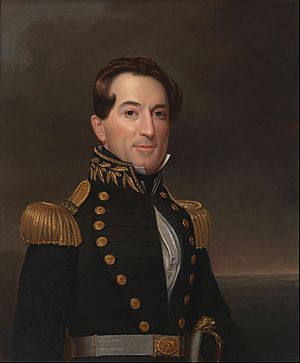
Farragut's navy career started when he was just nine years old. He served for 60 years until he died at age 69. He fought in several wars, most notably the American Civil War. During that war, he became famous for winning many important naval battles.
War of 1812 Service
Farragut officially joined the U.S. Navy in 1810 as a "boy," a low rank for young sailors. Thanks to his foster father, he became a midshipman (an officer in training) at age nine. By age 11, he was a "prize master," meaning he was in charge of a captured enemy ship.
He served on the ship USS Essex under his foster father, Captain Porter. In 1812, he helped capture a British ship called HMS Alert. He also helped set up America's first naval base in the Pacific, called Fort Madison, in the Marquesas Islands.
During a battle in Chile in 1814, Farragut was wounded and captured by the British. He was only 12 years old at the time.
Fighting Pirates in the West Indies
In 1823, Farragut received his first command: the schooner USS Ferret. He joined the "Mosquito Fleet," a group of ships sent to fight pirates in the Caribbean Sea. He worked with his old captain, Commodore Porter, who was leading the fleet.
For six months, Farragut and the fleet chased pirates from the sea and their hiding spots among the islands. He was promoted to lieutenant in 1825.
Mexican-American War
By 1847, Farragut was a commander. He took charge of the ship USS Saratoga. His ship was part of the Home Squadron during the Mexican–American War.
He helped blockade (block off) the port of Tuxpan in Mexico. He stayed there for two months, even though many sailors on board got yellow fever. After the war, his ship returned to New York and was taken out of service.
In 1853, Farragut was chosen to build the Mare Island Naval Shipyard near San Francisco, California. This was a very important job. In 1854, he arrived to start building the navy yard. It became the main port for ship repairs on the West Coast. Captain Farragut officially opened Mare Island on July 16, 1858.
Civil War Hero
Before the Civil War, Farragut lived in Virginia. But he strongly believed that leaving the Union was wrong. Just before the war started, he moved his family to New York.
He offered to serve the Union. At first, some people doubted his loyalty because he was born in the South and his wife was from Virginia. But his foster brother, David Dixon Porter, spoke up for him. Farragut was then chosen for the big task of attacking New Orleans.
In February 1862, Farragut was secretly put in command of the Gulf Blockading Squadron. He sailed with his flagship, the USS Hartford, and a fleet of 17 ships. They headed for the mouth of the Mississippi River. There, they faced two strong Confederate forts, Fort St. Philip and Fort Jackson, which had over 100 cannons. The Confederates also had 16 gunboats.
On April 18, Farragut ordered mortar boats to bombard the forts. After two days, he decided to sail his ships past the forts and the Chalmette batteries. On April 29, he captured New Orleans. This was a huge victory for the Union.
Congress honored him by creating the rank of rear admiral on July 16, 1862. This rank had never been used in the U.S. Navy before.
Later that year, Farragut tried to pass the Confederate defenses at Vicksburg, Mississippi. But a Confederate ironclad ship forced his fleet to retreat.
Challenges at Port Hudson
Farragut was a bold leader, but sometimes he didn't work well with others. At the siege of Port Hudson, the plan was for Farragut's ships to sail past the Confederate cannons while the Union Army attacked from land. The army attack was set for 8:00 a.m. on March 15, 1863.
However, Farragut decided to move his ships forward early, at 9:00 p.m. on March 14. This meant the army wasn't ready to help. The Confederates could then focus all their fire on Farragut's ships, causing a lot of damage.
Only two of Farragut's ships made it past the cannons. He then played no further part in the battle for Port Hudson. The Union Army had to continue the siege without naval support and suffered heavy losses.
Vicksburg surrendered on July 4, 1863. Port Hudson was the last Confederate stronghold on the Mississippi River. When it surrendered on July 9, the Confederacy was cut in two. Controlling the Mississippi River was a key part of the Union's plan to win the war.
Mobile Bay Victory
On August 5, 1864, Farragut won a great victory at the Battle of Mobile Bay. Mobile, Alabama, was the last major Confederate port on the Gulf of Mexico. The bay was full of naval mines, which were called "torpedoes" back then.
Farragut ordered his fleet to charge into the bay. When one ship, the USS Tecumseh, hit a mine and sank, other ships started to pull back.
From his high spot on his flagship, USS Hartford, Farragut saw them retreating. He famously shouted, "Damn the torpedoes! Four bells, Captain Drayton, go ahead. Jouett, full speed!" His fleet then successfully entered the bay. Farragut defeated the Confederate ships and forts, including Fort Morgan and Fort Gaines.
On December 21, 1864, President Lincoln promoted Farragut to vice admiral. This made him the highest-ranking officer in the U.S. Navy.
After the Civil War
After the war, Farragut continued to serve. He was promoted to full admiral on July 25, 1866. He was the first U.S. Navy officer to hold this rank.
His last active duty was commanding the European Squadron from 1867 to 1868. He remained on active duty for his entire life, a rare honor.
Death and Legacy
Admiral Farragut died from a heart attack on August 14, 1870, at age 69. He was on vacation in New Hampshire. He had served in the navy for almost 60 years. He is buried at Woodlawn Cemetery in New York City.
Family Life
Farragut married Susan Caroline Marchant in 1824. She suffered from poor health for many years and died in 1840. Farragut was known for being very kind and caring towards her.
In 1843, Farragut married Virginia Dorcas Loyall. They had one son, Loyall Farragut, born in 1844. Loyall Farragut later graduated from West Point and served in the U.S. Army.
Timeline of Service
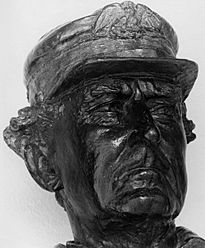
- 1810: Joined U.S. Navy as a "boy" and then a midshipman at age 9.
- 1812: Assigned to the frigate USS Essex.
- 1814: Wounded and captured during the War of 1812.
- 1823: Given command of the schooner USS Ferret.
- 1825: Promoted to lieutenant.
- 1838: Commanded the sloop-of-war USS Erie.
- 1841: Promoted to commander.
- 1847: Commanded USS Saratoga during the Mexican–American War.
- 1854: Began establishing the Mare Island Navy Yard in California.
- 1855: Promoted to captain.
- 1862: Promoted to flag officer (like a commodore).
- 1862: Commanded the West Gulf Blockading Squadron.
- April 1862: Captured New Orleans.
- July 1862: Promoted to rear admiral.
- March 1863: Commanded naval forces at the Battle of Port Hudson.
- August 1864: Won the Battle of Mobile Bay.
- December 1864: Promoted to vice admiral.
- April 1865: Was a pallbearer at Abraham Lincoln's funeral.
- July 1866: Promoted to admiral, the first in U.S. Navy history.
- 1867–1868: Commanded the European Squadron.
- August 1870: Died at age 69.
Honoring Admiral Farragut
The town of Farragut, Tennessee, near where he was born, is named in his honor.
Many places and things are named after Admiral Farragut:
- Farragut Square in Washington, D.C., has a statue of him. Two subway stations there are also named after him.
- There are statues of him in Boston, Massachusetts, and New York City.
- Farragut Naval Training Station in Idaho was a big naval training center during World War II. It's now Farragut State Park.
- Two types of U.S. Navy destroyers have been named for Farragut. Several individual ships have also carried his name.
- Admiral Farragut Academy in Florida is a military boarding school founded in 1933.
- Farragut High School in Tennessee and Farragut Career Academy in Chicago are also named after him. Their sports teams are often called "The Admirals."
- Farragut has been honored on several U.S. postage stamps.
- His face was featured on the 1891 $100 Treasury Note.
-
Bust of Farragut at the Tennessee State Museum
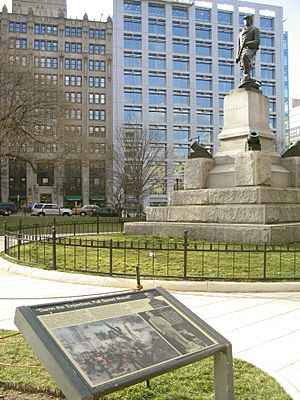
Numerous places and things are named in remembrance of Admiral Farragut:
- Admiral Farragut Academy is a college preparatory school with naval training founded in 1933 by navy admirals in Pine Beach, New Jersey. In 1945 the current and now only campus opened in St. Petersburg, Florida. In 1946 it was designated by Congress as a Naval Honor School.
- Farragut, Tennessee, Admiral Farragut's hometown of Campbell's Station (see Battle of Campbell's Station), Tennessee, was renamed Farragut when it became incorporated in 1982. Admiral Farragut was actually born at Lowe's Ferry on the Holston (now Tennessee) River a few miles southeast of the town, but at that time Campbell's Station was the nearest settlement.
- Farragut Square in Washington, D.C. is named in his honor.
- Farragut High School was built at Admiral Farragut's home town of Campbell's Station (now Farragut) in 1904. Today Farragut High School, boasting nearly 2,500 students, is one of the largest schools in Tennessee. The school's colors are blue and white, and its sporting teams are known as "The Admirals".
- Farragut, a neighborhood in Brooklyn
- Farragut Field is a sports field at the United States Naval Academy.
- Farragut Career Academy in Chicago, Illinois is a high school in the Chicago Public Schools system that was founded in 1894; its sporting teams are also known as the Admirals. The school displays an oil painting of the admiral, presented to the school by the Farragut Post of the Grand Army of the Republic in 1896. NBA star Kevin Garnett attended Farragut Career Academy. Wheel of Fortune host Pat Sajak is also a prominent alum.
- Farragut, Iowa is a small farming town in southwestern Iowa. Admiral Farragut's famous slogan greets visitors from a billboard on the edge of town. The local school, Farragut Community High School, fielded varsity "Admiral" and JV "Sailor" teams until its closure in 2016. The school also houses memorabilia from the ships that have borne the Farragut name.
- Five U.S. Navy destroyers have been named USS Farragut, including two class leaders.
- In World War II, the United States liberty ship SS David G. Farragut was named in his honor.
- Farragut Square, a park in Washington, D.C.; the square lends its name to two nearby Metro stations: Farragut North and Farragut West.
- Three U.S. postage stamps: the $1 stamp of 1903, the $0.03 stamp with Admiral David Porter in 1937 and a $0.32 stamp in 1995.
- 100-dollar Treasury notes, also called coin notes, of the Series 1890 and 1891, feature portraits of Farragut on the obverse. The 1890 Series note is called a $100 Watermelon Note by collectors, because the large zeroes on the reverse resemble the pattern on a watermelon.
- A stained glass window in the United States Naval Academy Chapel depicts Farragut in the rigging of USS Hartford at Mobile Bay.
- David Glasgow Farragut High School is the U.S. Department of Defense High School located on the Naval Station in Rota, Spain. Their sporting teams are also known as "The Admirals".
- Farragut Parkway in Hastings-on-Hudson, New York.
- Farragut Middle School in Hastings-on-Hudson, New York.
- David Farragut School in Philadelphia
- A grade school in Mayagüez, Puerto Rico.
- A grade school (PS 44) in the Bronx.
- Farragut State Park in Idaho, which was used as a naval base for basic training during World War II.
- A hotel in Menorca at Cala'n Forcat.
- A bust in full naval regalia on the top floor of the Tennessee State Capitol.
- Admiral Farragut condominium on waterway in Coral Gables, Florida.
- Farragut elementary school in Vallejo Ca. Located just outside the Mare Island Gate.
- A monument is located off Northshore Drive in Concord, Tennessee. The monument reads "BIRTHPLACE OF ADMIRAL FARRAGUT/BORN JULY 5, 1801 . . . DEDICATED BY ADMIRAL DEWEY, MAY 15, 1900".
- The David Farragut School is an elementary school in Boston, Massachusetts
- The Farragut House bar–restaurant located in South Boston, Massachusetts.
- A larger than life statue near the beach in South Boston.
- Farragut Bay, Alaska, by Thomas, 1887 [Latitude: 57.11889 : Longitude: -133.23056]
- Farragut Inn at Touro University California located on the Mare Island Naval Shipyard.
Monuments
- Madison Square Park, New York City, by Augustus Saint Gaudens, 1881, replica in Cornish, New Hampshire, 1994
- Farragut Square, Washington, D.C., by Vinnie Ream, 1881
- Marine Park, Boston Massachusetts, by Henry Hudson Kitson, 1881
- Hackley Park, Muskegon, Michigan, by Charles Niehaus, 1900
- A "Commodore Farragut", who is clearly based on David Farragut, appears in Jules Verne's 1870 novel Twenty Thousand Leagues Under the Sea.
- In the Star Trek franchise, a number of Starfleet starships are named Farragut.
- The album Damn the Torpedoes by Tom Petty and the Heartbreakers is named after David Farragut's famous quote.
- The album MDFMK by MDFMK contains a song entitled "Damn the Torpedoes".
- In the comedy film Galaxy Quest, Tim Allen's character says "Never give up! Never surrender! Damn the resonance cannons! Full speed ahead!"
- Farragut is played by actor Scott Brady in the feature film Yankee Buccaneer (1952)
- In her 2010 spoken-word debut, Olivia Hedrick released a track "How I love thee Mister Farragut"
- In the 1943 film The More the Merrier, Charles Coburn views the famous quote on a statue, and uses the phrase as a motto; it drives the plot forward.
- In the video game The Elder Scrolls 4: Oblivion, there is a Fort Farragut.
- In the opening scene of Damages, Season 2, Episode 10, Ellen Parsons and Wes Krulik meet to talk on the left-side seating within the Admiral Farragut Memorial in Madison Square, Manhattan.
- Among his last acting roles, Ronald W. Reagan played Farragut in the 1965 episode "The Battle of San Francisco Bay" of the syndicated western television series, Death Valley Days. The episode focuses on the 1856 San Francisco Vigilance Committee. June Dayton was cast in the episode as Farragut's second wife, Virginia.
- Farragut is mentioned in The Wild Wild West episode "The Night of the Kraken", although he does not appear. At the climax, the story's villains try to destroy Farragut's ship with a naval mine, but are foiled by the series' heroes.
- In season 4 episode 13 of M*A*S*H entitled "Soldier of the Month", Hawkeye asks the question, "What famous Civil War hero said, 'Damn the torpedoes! Full steam ahead!'?" Klinger replied, "Tugarraf", which is Farragut backwards.
See also
 In Spanish: David Farragut para niños
In Spanish: David Farragut para niños
- Naval history of the American Civil War
- Blockade runners of the American Civil War
- Naval battles of the American Civil War


